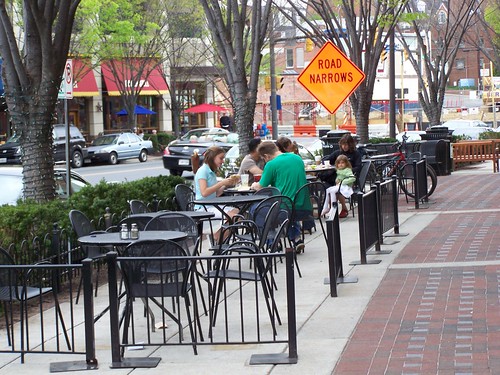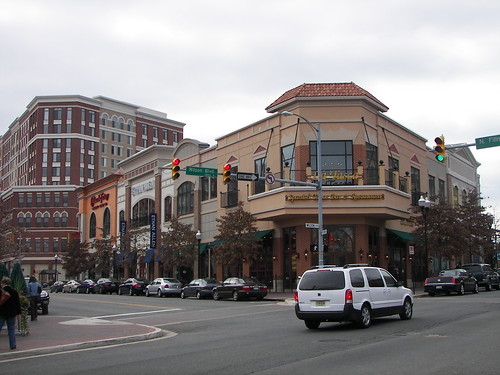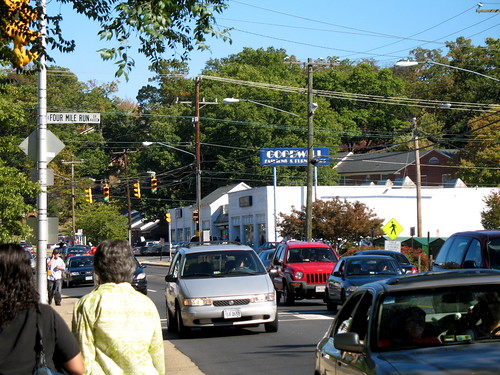The suburbs aren't dead, but they do need to change
Leigh Gallagher of Fortune Magazine has written a book, The End of the Suburbs, so she is getting great play with excerpts of her book in high profile media like Time Magazine ("The End of the Suburbs"), Slate ("The suburbs are dead — and that’s not a good thing"), and the Washington Post ("Have the suburbs hit a dead end?").
The book's title is punchy, but misleading, because even she doesn't argue that the suburbs are "over," just that deconcentrated sprawl isn't working any more, and needs to change. And the sub-head of the Slate article is definitely wrong:
The resurgence of cities has been awful on the 'burbs: More crime, poverty, burned-out malls and foreclosed homes
because these problems have absolutely nothing to do with the alleged resurgence of the cities, but have to do with the suburbs specifically, including fraud and structural problems with how the mortgage industry worked before the 2008 crash, overbuilding, and the fact that as a percentage of population, the suburban sections of metropolitan areas generally have significantly more population than the center city, so as a percentage, crime (but maybe not murder, depending on the area) and poverty in the suburbs is going to exceed eventually rates in the center cities, unless the center city is almost exclusively comprised of the poorest in the region.
Gawker gets it the best and most accurately, "The End of the Age of Suburbs.
It was the suburbs time from the late 1940s to 2008. Now trends are shifting, and need to shift. The cities are doing better, but even so suburbs are not a spent force, because the suburbs aren't homogeneous, and some developers are very much focused on maintaining the economic relevance of their investment--which is the reason behind the creation of the Silver Line subway serving parts of Fairfax and Loudoun counties. It's to position those places as relevant for 21st century development.
But the need for change isn't exclusive to the suburbs, and the issue isn't so much "urban vs. suburban" as it is compact, connected, sustainable mobility-enabled development vs. deconcentrated, disconnected, automobile-enabled pods of interspersed residential and commercial development spread across wider and wider expanses.
The real problem is that in the 21st century economy, a globally-connected world operates at a different scale than it did in the 19th and 20th centuries.
But our governance structures, politics, and the way we organize land use and mobility function at the level of the individual city, town, and county, the way that it made sense for the 19th and 20th centuries.
But in the 21st century, these systems need to operate at much bigger scales: metropolitan; regional; multi-state; national; and international.
And this is true for both the suburbs and the cities. It is not exclusively a problem of either.
And we don't have a mechanism for change, other than at the state level, or the creation of metropolitan governments, usually through the consolidation of a center city with the surrounding county. But such efforts can take decades to pull off.
The Washington DC Metropolitan area is a good place to consider these questions, because it is a region split up between three jurisdictions at the "state" level: the District of Columbia; Maryland; and Virginia.
Plus the federal government and its decisive role in the local economy, not to mention national politics. Plus the various sub-state jurisdictions of counties, cities, and towns, and semi-independent authorities like the Metropolitan Washington Airports Authority, the Metropolitan Washington Council of Governments, the various federal planning requirements on state and local jurisdictions, and the various development and financial interests, not to mention "residents."
Suburbs aren't dead. But they have to change.
Similarly, cities aren't the new center of the universe, but they have to change too, in order to fully reap the benefit of changing circumstances and trends favoring denser, more connected living.
 Bethesda Row.
Bethesda Row.The Washington Metropolitan region has plenty of examples of significant change in real estate development practices, including:
• Bethesda Row, one of the first "Row" mixed use developments by Federal Realty, which has become a national model;
• Rockville Town Center, also in Montgomery County;
• redevelopment in Silver Spring in the "Downtown Silver Spring" project, arts uses on Colesville Road, etc.;
& bull; the redevelopment of White Flint
• and the redevelopment of Tysons Corner in Virginia both of which have been written about plenty here;
• as is the "Arlington model" of transit oriented redevelopment along the Wilson Boulevard corridor, especially from the Courthouse to the Ballston subway stations, anchored by Clarendon and Ballston;
• but also in a new stage in Rosslyn;
• of course, transit oriented development in DC is key, including at the Navy Yard (Capitol Riverfront BID), NOMA, Petworth, Columbia Heights, Mount Vernon Triangle and the Penn Quarter area, redevelopment around Foggy Bottom, etc.
• the intensification of Reston Town Center; etc.
And now even newer examples further out, from the Mosaic District in Merrifield in Fairfax County to the Loudoun Station development in Loudoun County by Roadside Development.
 Clarendon.
Clarendon.In either case, city or suburb, most of the time residents and elected officials seem to be resistant to considering how to develop a way forward, despite all of these examples, ranging from opposition to streetcars in the city or suburbs against light rail in the suburbs, and significant underzoning on the part of suburban officials such as in Montgomery County (as discussed in the recent piece by Dan Reed at GGW, "Montgomery nervous about density around Purple Line stops").
The Post--remember that newspapers are the first draft of history--has lots of articles about these changes, but there is no overarching analysis.
Recent articles, on Columbia Pike in Virginia, H Street in DC, and 14th Street in DC, and Clarksburg in Montgomery County all touch on this issue of change in the face of increased demand for denser development, and for living proximate to transit. These articles offer different sides of the change, and show resistance to clarifying the planning and development rules to best shape the change.
-- "From Bocce to a Trolley in a Washington Neighborhood," New York Times
-- "The 20-year-old plan for Clarksburg Town Center," Washington Post
-- "Farewell to Chocolate City," New York Times
-- "Gentrification in overdrive on DC's 14th Street," Washington Post
-- "Diversity and development on Columbia Pike," Washington Post
-- "D.C.'s H Street embedded with deaf culture," Washington Post
 Left: Columbia Pike, Arlington County, Virginia. Flickr photo by Mississippi Snopes.
Left: Columbia Pike, Arlington County, Virginia. Flickr photo by Mississippi Snopes.Most people, residing in either the cities or the suburbs, aren't willing, interested and accepting of the counter-thesis, that in the 21st century, our neighborhoods, subdivisions, cities, and counties to be competitive, the way we do things has to change. (Also see "Why Are There So Few Starbucks in Montgomery County?" from Patch.)
To be competitive, these relationships need to reorganized in ways that make better use of increasingly scarce resources, specifically land and energy. In particular, the spatial relationships between residential choice, employment location, and transportation have to change.
And that means denser living, less dependence on the car, and more focus on walking, biking, and transit.
And changes to governance structures and planning regimes.
Again, these changes are required not just in the suburbs, but for the cities too.*
But "End of the Suburbs" makes for a much punchier title and thesis.
------
One example of how the issues are usually very similar is that I find Urban Land Institute publications on how to improve "the suburbs" just as useful for addressing city-related issues as they are for the suburbs.
• Reinventing Suburban Business Districts
• Reinventing America's Suburban Strips
• Ten Principles for Rethinking the Mall
• Ten Principles for Developing Successful Town Centers
Plus, the Build A Better Burb project out of Long Island is equally relevant to cities. It's a great resource.
Labels: car culture and automobility, compact development, electoral politics and influence, land use planning, sprawl, suburban revitalization, transportation planning, urban revitalization




0 Comments:
Post a Comment
<< Home